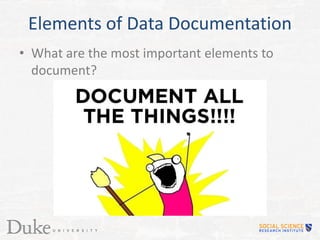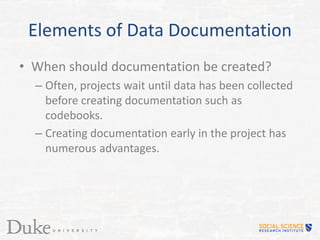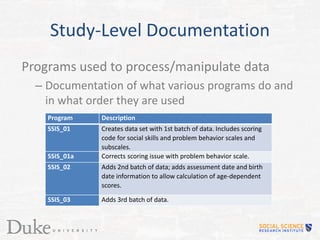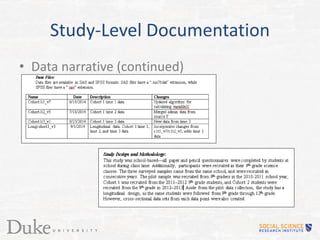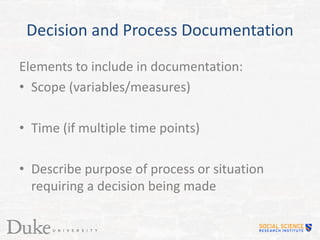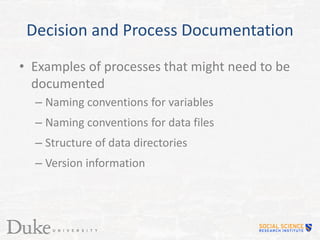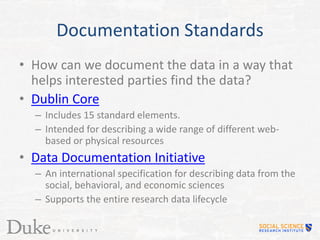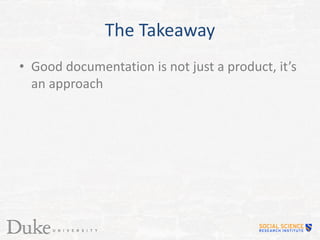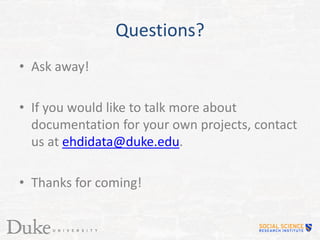Elements of Data Documentation
- 1. Elements of Data Documentation Adam Mack Education and Human Development Incubator (EHDi) Social Science Research Institute October 1, 2015
- 2. Why Is Documentation Important? • Describe the contents of the data • Explain context in which data was collected • Explain any manipulations performed on the data • Allow research data to be understood by people outside of the original project
- 3. Do I Need to Document? Back in the day… … and now. Research:
- 5. Consequences of Insufficient Documentation • Data may be unusable • May make inaccurate assumptions about data – Manipulations performed on data may affect results of analyses – May be unclear how to interpret contents of a variable
- 6. Consequences of Insufficient Documentation: Example • Assume each of the following prompts is answered on a 1–5 agreement scale. – Data management is great. (dmgreat) 5 – Data management is the greatest! (dmgrtst) 5 – I don’t like data management. (dmnolike) 1 • Dmnolike needs to be reversed scored (to 5) before a scale score can be calculated from the variables. • You can recode this value within the same variable, but should you?
- 7. Elements of Data Documentation • What are the most important elements to document?
- 8. Elements of Data Documentation • What are the most important elements to document? – Data elements – Study elements – Processes and decisions
- 9. Elements of Data Documentation • Who will be using the documentation? – Data managers – Statisticians – Researchers – Outside users
- 10. Elements of Data Documentation • When should documentation be created? – Often, projects wait until data has been collected before creating documentation such as codebooks. – Creating documentation early in the project has numerous advantages.
- 11. Elements of Data Documentation • How should these elements be documented? Potential forms that documentation may take include: – Codebook
- 12. Elements of Data Documentation • How should these elements be documented? Potential forms that documentation may take include: – Annotated version of instrument
- 13. Elements of Data Documentation • How should these elements be documented? Potential forms that documentation may take include: – More descriptive, less structured forms of documentation (data narratives)
- 14. Data-Level Documentation • What are the most important elements to document? – Data elements – Study elements – Processes and decisions
- 15. Data-Level Documentation Should include basic information needed to use the data, including: • Structural information about variable – Name of variable – Label (if applicable) – Type of variable (numeric or character) – Length of variable
- 16. Data-Level Documentation • Information describing variable contents – Question text (or text description of variable contents) – Valid values – Coding of values
- 17. Data-Level Documentation • Scales/derived variables – Algorithm used to create variable – Procedures for handling missing data
- 18. Data-Level Documentation • Question routing (if skip patterns used) – Identify number of participants asked each question/path through survey • Error checking/validation
- 19. Data-Level Documentation • Reliability of scales – Calculate Cronbach’s alpha for each scale included in the data – Compare values for your study to previously reported values in the literature
- 20. Types of Data Documentation • Tabular codebook (Excel) – Good for organizing a large amount of information concisely – Sortable – Filterable – Customizable; can hide columns that may be needed but are not of interest to a general audience
- 21. Tabular Codebook
- 22. Types of Data Documentation • Annotated instrument – Contains basic variable and value information in context – Easy to interpret – Difficult to integrate much additional detail; not useful for some forms of data
- 24. Study-Level Documentation • What are the most important elements to document? – Data elements – Study elements – Processes and decisions
- 25. Study-Level Documentation • Details about the source of the data – Study design and purpose – Collection method – Information about the research sample – Longitudinal time points (if applicable)
- 26. Study-Level Documentation • Information about data files – File name/version – Date created – Number of records – Number of variables – Changes since last version of file
- 27. Study-Level Documentation • Information about measures used – Description of measure – Description of scales – Source of measure, including references as appropriate
- 28. Study-Level Documentation Programs used to process/manipulate data – Documentation within program (comments)
- 29. Study-Level Documentation Programs used to process/manipulate data – Documentation of what various programs do and in what order they are used Program Description SSIS_01 Creates data set with 1st batch of data. Includes scoring code for social skills and problem behavior scales and subscales. SSIS_01a Corrects scoring issue with problem behavior scale. SSIS_02 Adds 2nd batch of data; adds assessment date and birth date information to allow calculation of age-dependent scores. SSIS_03 Adds 3rd batch of data.
- 30. Study-Level Documentation • Data narrative – Good for measure/study-level information
- 31. Study-Level Documentation • Data narrative (continued)
- 32. Decision and Process Documentation • What are the most important elements to document? – Data elements – Study elements – Processes and decisions
- 33. Decision and Process Documentation • By far, the least established area of research documentation. • Due to individual differences between research projects, it can be difficult to identify a standard template.
- 34. Decision and Process Documentation Elements to include in documentation: • Scope (variables/measures) • Time (if multiple time points) • Describe purpose of process or situation requiring a decision being made
- 35. Decision and Process Documentation Elements to include in documentation: • Information from the data that describes or affects the decision or process • A description of the process itself, including: – Any software or tools needed to complete the process – Any resources /references used
- 36. Decision and Process Documentation • What sorts of decisions and processes should be documented with this level of detail? – Basic scales and processes that are commonly utilized may not require this much detail – Processes and procedures that are not well established or that deviate significantly from the standard method should be documented
- 37. Decision and Process Documentation • Examples of processes that might need to be documented – Naming conventions for variables – Naming conventions for data files – Structure of data directories – Version information
- 38. Decision and Process Documentation • Examples of decisions that might need to be documented – Resolving discrepancies in data obtained from multiple sources or at multiple time points – Data transformations that require interpretation
- 39. Decision and Process Documentation
- 40. Tools for Documentation • Statistical software packages (e.g. SAS, Stata) – Variable information (PROC contents; describe) – Provides a good starting point for a codebook • Database management systems
- 41. Tools for Documentation • Data collection instruments – Paper forms – Electronic/online collection
- 42. PROC CODEBOOK (SAS) • PROC CODEBOOK is a SAS macro that creates a codebook based on a SAS data set
- 43. PROC CODEBOOK (SAS) • Requirements – Labels on variables and data set – Formats assigned to categorical values – Minimum of 1 categorical/2 numeric variables • Optional elements – Ordering of variables (default is by variable name) – ODS formatting of title text
- 44. PROC CODEBOOK (SAS) • Can be useful when dealing with data sets that include SAS formats • If data set does not already have formats applied, may take as much time to add them as to create your own codebook (which has more flexibility) • To download the SAS macro and access documentation, visit http://www.cpc.unc.edu/research/tools/data_an alysis/proc_codebook
- 45. Documentation Standards • How can we document the data in a way that helps interested parties find the data? • Dublin Core – Includes 15 standard elements. – Intended for describing a wide range of different web- based or physical resources • Data Documentation Initiative – An international specification for describing data from the social, behavioral, and economic sciences – Supports the entire research data lifecycle
- 46. The Takeaway • Good documentation is not just a product, it’s an approach
- 47. Resources • Inter-university Consortium for Political and Social Research (ICPSR) – Guide to Social Science Data Preparation and Archiving • Cornell Research Data Management Service Group – Guide to writing "readme" style metadata • Duke University Libraries
- 48. Questions? • Ask away! • If you would like to talk more about documentation for your own projects, contact us at [email protected]. • Thanks for coming!
- 49. Acknowledgements For their help in putting together this workshop: • Lorrie Schmid • Chandler Thomas And for helping keep you interested in the material: • Darth Vader • Success Kid • Mark Wahlberg (and @ResearchMark)






